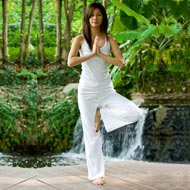- Aromatherapy (36)
- Benefits of Yoga (282)
- Home Remedies (1087)
- massage therapy (9)
- Preventive Therapy (135)
- Running (41)
- Skin Care (15)
- Stress Relief (25)
- Stretching (5)
- walking (33)
- Womens Health (14)
- Yoga Benefits for Pregnant Women (16)
- Yoga Benefits for Students (3)
- Yoga for Children (11)
- Yoga for Holistic Living (37)
- Yoga for Midlife Crisis (3)
- Yoga for Senior Citizens (2)
- Yoga for the Workplace (1)
- Yoga Health Tips (185)
- Yoga Practice during Menstruation (5)
Standing Pranayama

Yes, Pranayama (breathing techniques) can be done standing erect. There is no rule insisting that pranayama must or should be done sitting down. In fact, it can even be done lying in the supine position. The benefits, however, will differ.
Yoga is a very precise science and holistic art of living that has been perfected by sages down the centuries and nothing has been arrived at by accident. All its styles and techniques have evolved out of a certain need, primarily to bring about a balance between the different systems and organs of the body and a balance between the body, the conflicting thoughts and emotions, and the divine. To this extent, it cannot be said that the whole body of Yoga is the work of any one individual. While it is true that the sage Patanjali had, thousands of years ago, compiled the rules and regulations of Yoga in his Yoga sutras, the myriad other practices are the contributions of hundreds, maybe even thousands of yogis.
They all observed nature, their surroundings, the different creatures and came up with different techniques that, they felt, if practiced and followed, would give optimum benefits to the practitioner. Coming specifically to pranayamas or breathing techniques; pranayama means control and regulation of energy (prana = bio energy + yama = control/restraint) through the breath. The breath is the source of life in the body and the best way of harnessing energy, they felt, is through breathing. Most of us breathe shallowly, using hardly 45 – 50% of our lung capacity. The first step in pranayama is to increase our breathing capacity. The yogis felt that this could be achieved by correcting our breathing techniques. Most people, they found, either breathed clavicularly or thoracically, both of which render our breathing shallow.
So the first step they came up with, in pranayama, was dirga pranayama techniques or the full yogic breath, which involves muscles of the diaphragm, thorax and clavicular muscles. This done, they set about devising ways and means of harnessing the different pranas and channelizing them to the remotest parts of the body. This took centuries of work and all that they came up with was painstakingly accurate. Inasmuch as postures were concerned, they found that pranayama is best practised in a sitting position because this is where you are able to breathe to your fullest without toppling and falling over (if done standing) and without falling asleep (if done lying down).
Besides, pranayama is a precursor to meditation, which is also advocated in a sitting position. Both pranayama and meditation, it has been found, deliver optimum benefits if done sitting in the prescribed meditative postures: Sukhasana (easy pose) or Padmasana (lotus pose) or Vajrasana (warrior pose), so on and so forth. So, while it would not be wrong to practice pranayama standing or lying down, you would only derive the optimum benefits if you practiced it while seated in any meditative posture.
- RSS Feeds -
- All posts
- All comments
- Benefits Of Suryabhedana Pranayama It is claimed that if one practices Suryabhedana the practitioner is not trou...
- Broad Overview On Pranayama Pranayama, the Yoga breathing technique is a very important part of the scien...
- Pranayama Breathing Techniques In yoga, pranayama is the science of breath control. Without breath, there is...
- Pregnancy Yoga Techniques Pregnancy carries with it a number of risks. However, all these risks are wor...